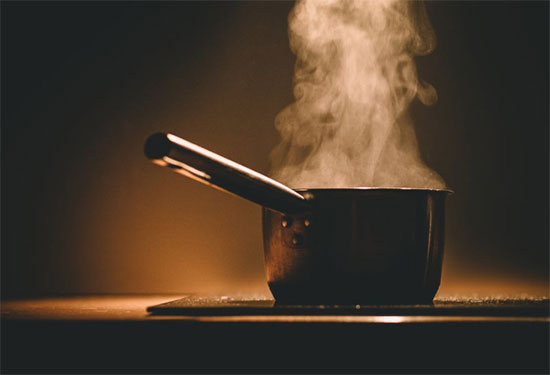Kitchen safety should be one of your top priorities at home. Did you know that the kitchen is considered the most dangerous room in the house? Kitchen accidents that lead to emergency room visits include knife cuts, burns, poisoning and more. How can you be safe in your kitchen and prevent accidents from happening?
If you spend a lot of time in a kitchen, at a guess, you have scars from knife mishaps. When I was a pre-teen, I was banned from using the serrated knife due to an injury I caused myself! You might be burned in several places from handling roasting pans. Or, thanks to splashing fat, there are parts of you where hair will never grow again. It’s amazing so many people consider cooking to be a job for the gentle. Those of us who do it often know the kitchen can be akin to a war zone. If you want to emerge from it largely unscathed, it helps to know what to avoid. Here are some kitchen safety tips:
Cooking In A Saucepan? Stir Away From Your Body.
Yes, you tend to stir in a circle, so at some point you’re always coming back towards you. However, if using a slotted or serving spoon, or anything with a bowl shape on the end, position that bowl facing away. If your hand jerks – and it happens to us all – you don’t want to be scooping boiling water or hot sauce all over you!
Never Cook In Bare Feet
This kitchen safety tip may seem like a no-brainer, but trust me, people do this. If you have a day off, it’s always nice to get up late and have an indulgent breakfast like waffles with sausage and eggs. If you’ve ambled into the kitchen in your pajamas, chances are you’re not as awake nor as dextrous as you’d usually be. So if you accidentally jar a knife off the worktop, the time between it falling and landing is just long enough to wake up and realize KNIVES + FEET = BAD. By which time it may be too late.
Kitchen Safety Technique: Learn How To Chop Onions
If you don’t have a gadget that chops onions easily for you (like me), here’s a safe technique: You start by chopping off the more stalk-like of the two ends, then place that end on the board and halve it vertically. From this point on, you can freestyle depending on the fineness of cut you want (finer for sauces, rough for a slaw) but always lay an onion flat side down. The Japanese steel of the best kitchen knives will carve through fish, onion, pepper and your hand very easily. Always make sure you’ve got a secure base to work on.
Remember: Pans Get Heavy
I’ve been painfully aware of this since my accident a year ago. It is only in the past few weeks that my left arm has been strong enough to start handling pots! Now, one of the coolest ways to serve an omelet is to slide it from pan to plate (espeically if you’re using a non-stick pan!). Little presentational flourishes like that can make you feel pretty good. That said, if you’re using a cast iron skillet, it might become less flourish and more floor-ish, as they have some serious heft (and aren’t that non-stick).
Yes, that sounds like a joke, but remember that a saucepan full of pasta or indeed anything made of cast iron is fine for cooking, but the longer you’re holding it the more likely you are to drop or spill – both of which can cause even bigger hazards if you slip on them. Set pans down on protective heat pads if you’re not immediately going to pour something from them.
I hope these tips will help keep you safe in the kitchen. If you have any other saftey tips, please share them below in a comment!


